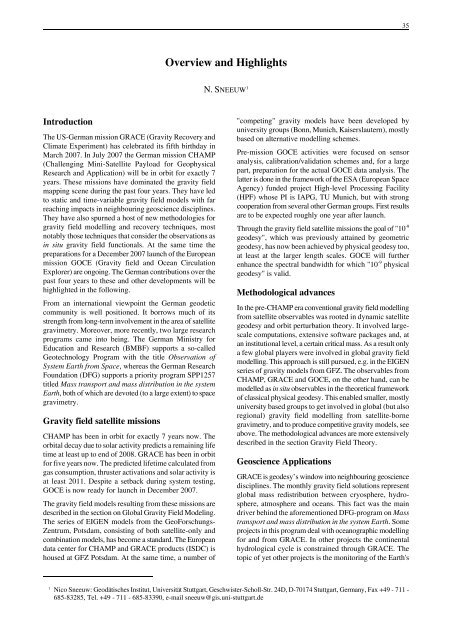NATIONAL REPORT OF THE FEDERAL REPUBLIC OF ... - IAG Office
NATIONAL REPORT OF THE FEDERAL REPUBLIC OF ... - IAG Office
NATIONAL REPORT OF THE FEDERAL REPUBLIC OF ... - IAG Office
Create successful ePaper yourself
Turn your PDF publications into a flip-book with our unique Google optimized e-Paper software.
Introduction<br />
The US-German mission GRACE (Gravity Recovery and<br />
Climate Experiment) has celebrated its fifth birthday in<br />
March 2007. In July 2007 the German mission CHAMP<br />
(Challenging Mini-Satellite Payload for Geophysical<br />
Research and Application) will be in orbit for exactly 7<br />
years. These missions have dominated the gravity field<br />
mapping scene during the past four years. They have led<br />
to static and time-variable gravity field models with far<br />
reaching impacts in neighbouring geoscience disciplines.<br />
They have also spurned a host of new methodologies for<br />
gravity field modelling and recovery techniques, most<br />
notably those techniques that consider the observations as<br />
in situ gravity field functionals. At the same time the<br />
preparations for a December 2007 launch of the European<br />
mission GOCE (Gravity field and Ocean Circulation<br />
Explorer) are ongoing. The German contributions over the<br />
past four years to these and other developments will be<br />
highlighted in the following.<br />
From an international viewpoint the German geodetic<br />
community is well positioned. It borrows much of its<br />
strength from long-term involvement in the area of satellite<br />
gravimetry. Moreover, more recently, two large research<br />
programs came into being. The German Ministry for<br />
Education and Research (BMBF) supports a so-called<br />
Geotechnology Program with the title Observation of<br />
System Earth from Space, whereas the German Research<br />
Foundation (DFG) supports a priority program SPP1257<br />
titled Mass transport and mass distribution in the system<br />
Earth, both of which are devoted (to a large extent) to space<br />
gravimetry.<br />
Gravity field satellite missions<br />
CHAMP has been in orbit for exactly 7 years now. The<br />
orbital decay due to solar activity predicts a remaining life<br />
time at least up to end of 2008. GRACE has been in orbit<br />
for five years now. The predicted lifetime calculated from<br />
gas consumption, thruster activations and solar activity is<br />
at least 2011. Despite a setback during system testing,<br />
GOCE is now ready for launch in December 2007.<br />
The gravity field models resulting from these missions are<br />
described in the section on Global Gravity Field Modeling.<br />
The series of EIGEN models from the GeoForschungs-<br />
Zentrum, Potsdam, consisting of both satellite-only and<br />
combination models, has become a standard. The European<br />
data center for CHAMP and GRACE products (ISDC) is<br />
housed at GFZ Potsdam. At the same time, a number of<br />
Overview and Highlights<br />
N. SNEEUW 1<br />
1 Nico Sneeuw: Geodätisches Institut, Universität Stuttgart, Geschwister-Scholl-Str. 24D, D-70174 Stuttgart, Germany, Fax +49 - 711 -<br />
685-83285, Tel. +49 - 711 - 685-83390, e-mail sneeuw@gis.uni-stuttgart.de<br />
35<br />
"competing" gravity models have been developed by<br />
university groups (Bonn, Munich, Kaiserslautern), mostly<br />
based on alternative modelling schemes.<br />
Pre-mission GOCE activities were focused on sensor<br />
analysis, calibration/validation schemes and, for a large<br />
part, preparation for the actual GOCE data analysis. The<br />
latter is done in the framework of the ESA (European Space<br />
Agency) funded project High-level Processing Facility<br />
(HPF) whose PI is IAPG, TU Munich, but with strong<br />
cooperation from several other German groups. First results<br />
are to be expected roughly one year after launch.<br />
Through the gravity field satellite missions the goal of "10-9 geodesy", which was previously attained by geometric<br />
geodesy, has now been achieved by physical geodesy too,<br />
at least at the larger length scales. GOCE will further<br />
enhance the spectral bandwidth for which "10-9 physical<br />
geodesy" is valid.<br />
Methodological advances<br />
In the pre-CHAMP era conventional gravity field modelling<br />
from satellite observables was rooted in dynamic satellite<br />
geodesy and orbit perturbation theory. It involved largescale<br />
computations, extensive software packages and, at<br />
an institutional level, a certain critical mass. As a result only<br />
a few global players were involved in global gravity field<br />
modelling. This approach is still pursued, e.g. in the EIGEN<br />
series of gravity models from GFZ. The observables from<br />
CHAMP, GRACE and GOCE, on the other hand, can be<br />
modelled as in situ observables in the theoretical framework<br />
of classical physical geodesy. This enabled smaller, mostly<br />
university based groups to get involved in global (but also<br />
regional) gravity field modelling from satellite-borne<br />
gravimetry, and to produce competitive gravity models, see<br />
above. The methodological advances are more extensively<br />
described in the section Gravity Field Theory.<br />
Geoscience Applications<br />
GRACE is geodesy’s window into neighbouring geoscience<br />
disciplines. The monthly gravity field solutions represent<br />
global mass redistribution between cryosphere, hydrosphere,<br />
atmosphere and oceans. This fact was the main<br />
driver behind the aforementioned DFG-program on Mass<br />
transport and mass distribution in the system Earth. Some<br />
projects in this program deal with oceanographic modelling<br />
for and from GRACE. In other projects the continental<br />
hydrological cycle is constrained through GRACE. The<br />
topic of yet other projects is the monitoring of the Earth's











